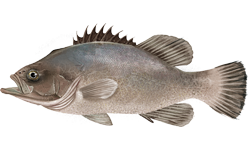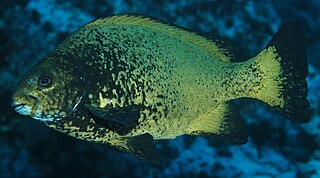
The wreckfish are a small group of ray-finned fish in the genus Polyprion, belonging to the monotypic family Polyprionidae in the order Acropomatiformes.

The sea chubs, also known as rudderfish and pilot fish and in Hawaiian as enenue or nenue, are a family, Kyphosidae, of fishes in the order Perciformes native to the Atlantic, Indian and Pacific Oceans usually close to shore in marine waters.
Ageneiogarra is a genus of freshwater ray-finned fishes belonging to the family Cyprinidae, which ncludes the carps, barbs and related fishes. The fishes in this genus are found in southeastern and eastern Asia.

Puntioplites is a genus of freshwater ray-finned fish belonging to the family Cyprinidae, the family which includes the carps, barbs, minnows and related fishes. The fishes in this genus are found in eastern Asia.

Plesiomyzon is a monospecific genus of freshwater ray-finned fish belonging to the family Gastromyzontidae, a group which shares the common name hillstream loaches with the family Balitoridae. The only species in the genus is Plesiomyzon baotingensis, a loach that is endemic to the river systems of Hainan.
Acanthopsoides is a genus of freshwater ray-finned-fishes belonging to the family Cobitidae, the true or spined loaches. These small fishes are found in Asia.

Serpenticobitis, popularly known as serpent loaches, is a small genus of loaches found in the Mekong River Basin in Southeast Asia. It is the only genus in the family Serpenticobitidae.

Bangana is a genus of fish in the family Cyprinidae, the carps and minnows. It is distributed across much of southern and eastern Asia. Species live mainly in the flowing waters of tropical and subtropical rivers.

Diplocheilichthys is a genus of freshwater ray-finned fish belonging to the family Cyprinidae, the carps, barbs, minnows and related fishes. The two species which belong to this genus are found in East Malaysia and Indonesia.

Osteochilus is a genus of freshwater ray-finned fish belonging to the family Cyprinidae, the family which includes the carps, barbs, minnows and related fishes. The fishes in this genus are mainly found in Southeast Asia with a few extending into adjacent parts of China.

Procypris is a genus of freshwater ray-finned fish belonging to the family Cyprinidae, the family which includes the carps, barbs, minnows and related fishes. The fishes in this genus are found in eastern Asia.
Qianlabeo is a monospecific genus of freshwater ray-finned fish belonging to the family Cyprinidae, the family which also includes the carps, barbs, minnows and related fishes. The ony species in the genus is Qianlabeo striatus which is endemic to the Pearl River drainage, Guizhou, China.
Semilabeo is a genus of freshwater ray-finned fish belonging to the family Cyprinidae, the family which includes the carps, barbs. minnows and related fishes. The fishes in this genus are found in southern China and Viet Nam.
Sinilabeo is a genus of freshwater ray-finned fish belonging to the family Cyprinidae, the family which includes the carps, barbs. minnows and related fishes. The fishes in this genus are found in China.
Sinocrossocheilus is a genus of cyprinid fish endemic to fast-flowing rivers in China and sometimes found in caves.

Homalopteroides is a genus of freshwater ray-finned fishes belonging to the family Balitoridae, the loaches in this family are commonly known as hillstream loaches although this name also refers to the loaches in the family Gastromyzontidae. These loaches are found in Southeast Asia.
Stenorynchoacrum is a monospecific genus of freshwater ray-finned fish belonging to the family Cyprinidae, the family which also includes the carps, barbs, minnows and related fishes. The only species in the genus is Stenorynchoacrum xijiangensis a species endemic to China. It is only known from Guangxi Province where it occurs in a tributary of the Zhujiang River.
Speolabeo is a genus of of freshwater ray-finned fish belonging to the family Cyprinidae, the family which also includes the carps, barbs, minnows and related fishes. The fishes in this genus are found in Viet Nam and Laos.
Schismatorhynchos endecarhapis is a species of freshwater ray-finned fish belonging to the family Cyprinidae, the family which includes the carps, barbs. minnows and related fishes. This species is endemic to central Borneo where it occurs in the upper parts of the drainage basins of the Kapuas River and the Barito River in Kalimantan. It occurs in rivers with fast currents where the riverbed has gravel, stones or rocks.
Schismatorhynchos holorhynchos is a species of freshwater ray-finned fish belonging to the family Cyprinidae, the family which includes the carps, barbs. minnows and related fishes. This species is endemic toBorneo where it occurs only in Eastern Malaysia, in the Rajang River system in Sarawak and Sabah and in the basin of the Kinabatangan River. It is found in fast flowing rivers with gravel, rocky or stony beds.










